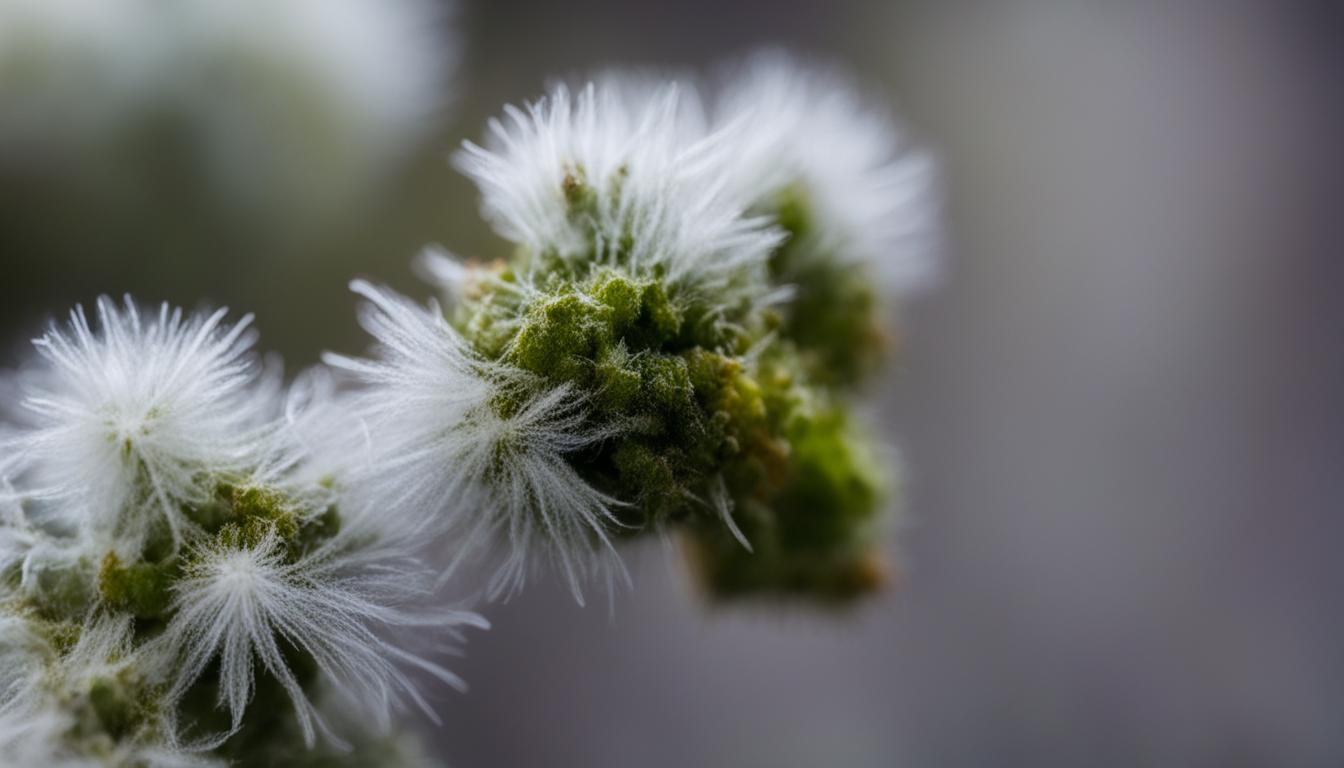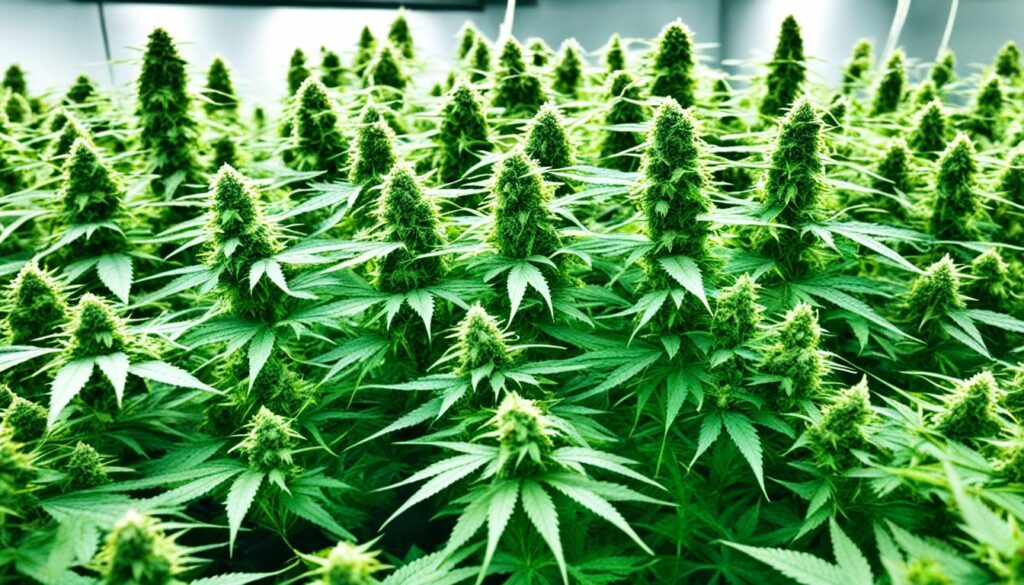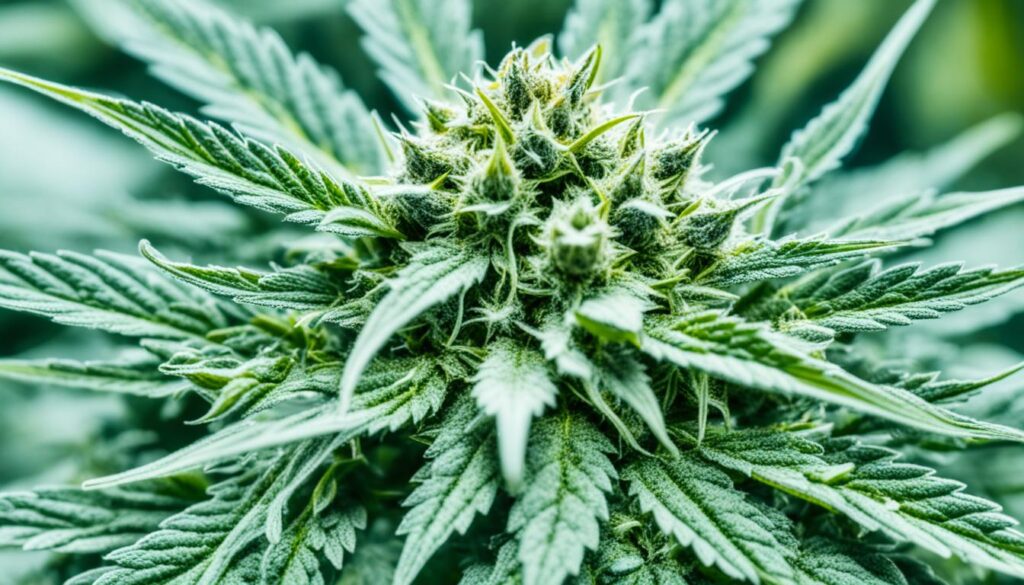
Preventing and Identifying Mold on Weed Safely
Welcome to our comprehensive guide on preventing and identifying mold on weed. As cannabis enthusiasts, it is crucial to prioritize safety and purity in our consumption. Mold growth on marijuana plants can not only compromise the quality of the weed but also pose potential health risks when smoked or ingested.
In this article, we will explore the dangers of consuming moldy weed, provide practical techniques for preventing mold growth, and guide you on how to identify and treat mold on marijuana. By implementing these strategies, you can ensure the safety of your cannabis products and enjoy a clean and potent experience.
Key Takeaways:
- Mold growth on weed can lead to compromised quality and potential health risks.
- Implement proper humidity control, ventilation, and sanitation practices to prevent mold.
- Visual signs, such as discoloration and unusual textures, can help identify mold on weed.
- Musty smell and respiratory symptoms may indicate the presence of mold.
- Professional mold remediation services, like Fix Mold Miami at 305-465-6653, can assist in treating mold on marijuana.
Understanding the Dangers of Mold on Weed
Mold growth on weed can pose significant risks to both health and the overall quality of the cannabis product. Consuming moldy weed can lead to various health issues, ranging from mild allergic reactions to severe respiratory problems. Additionally, mold can compromise the potency and flavor of marijuana, greatly diminishing the user’s experience.
Preventing mold growth in marijuana plants is crucial to ensure a safe and enjoyable cannabis consumption. By implementing effective marijuana mold prevention techniques and practicing cannabis mold control, individuals can safeguard their health and maintain the quality of their weed.
Let’s take a closer look at the potential dangers associated with mold on weed:
- Health risks: Mold on weed can release harmful spores that, when inhaled or ingested, can irritate the respiratory system and trigger allergic reactions. Individuals with weakened immune systems or respiratory conditions are particularly vulnerable to these health risks.
- Quality compromise: Mold growth on marijuana plants can significantly diminish the potency and flavor of the product. The presence of mold can result in a musty smell and unpleasant taste, making the consumption experience less desirable.
Understanding these dangers underscores the importance of taking proactive measures to prevent mold growth in marijuana plants. By prioritizing marijuana mold prevention and cannabis mold control, individuals can ensure the safety and purity of their weed.
“Preventing mold growth in marijuana plants is crucial to ensure a safe and enjoyable cannabis consumption.”
Techniques for Preventing Mold on Weed
Preventing mold growth on weed is essential to maintain the safety and quality of cannabis products. By implementing appropriate techniques, growers can ensure that their marijuana plants remain mold-free throughout the cultivation process.
Proper Humidity Control
One of the key factors contributing to mold growth in marijuana plants is excessive humidity. High humidity levels create a favorable environment for mold spores to develop and thrive. To prevent this, it is essential to maintain the humidity levels within the optimal range.
Typically, the recommended humidity level during the vegetative stage is around 50-70%, while during the flowering stage, it should be slightly lower, around 40-50%. Using a hygrometer is an effective way to monitor the humidity levels in the grow room or cultivation area.
Appropriate Ventilation
Proper ventilation is crucial for preventing mold in marijuana plants. It helps to maintain fresh air circulation, removing excess moisture and reducing the risk of mold development. Adequate ventilation also aids in controlling temperature and preventing the buildup of stagnant air.
Growers can utilize exhaust fans, intake fans, and air filters to create a well-ventilated environment. Additionally, strategic placement of fans within the grow space can help maintain steady air movement, preventing the conditions favorable for mold growth.
Effective Sanitation Practices
Implementing effective sanitation practices is essential to prevent the spread of mold spores and maintain a clean growing environment. Regular cleaning of equipment, surfaces, and grow room surfaces helps to eliminate any potential sources of mold contamination.
Sanitizing tools, trays, and containers with a mixture of water and hydrogen peroxide (1:9 ratio) or a mild bleach solution (1 part bleach to 10 parts water) can effectively kill mold spores. It is important to rinse and dry the sanitized items thoroughly before use.
Furthermore, maintaining proper hygiene by wearing clean and sterile gloves while handling plants, and minimizing the entry of pests, can also contribute to preventing mold growth.
Remember, preventing mold in marijuana plants is crucial not only for the health and well-being of consumers but also for the preservation of the quality and potency of the cannabis. By implementing proper humidity control, maintaining appropriate ventilation, and practicing effective sanitation, growers can significantly reduce the risk of mold development and ensure safe and mold-free weed.

| Mold Prevention Techniques | Description |
|---|---|
| Proper Humidity Control | Maintain optimal humidity levels during different growth stages. |
| Appropriate Ventilation | Create a well-ventilated environment to prevent excess moisture buildup. |
| Effective Sanitation Practices | Regularly clean equipment, surfaces, and implements sanitation techniques. |
Identifying Mold on Weed
When it comes to cannabis consumption, ensuring the quality and safety of the product is of utmost importance. Mold growth on weed can not only compromise the experience but also pose potential health risks. Knowing how to identify mold on cannabis is essential for every consumer.
One of the most apparent visual signs of mold on weed is discoloration. Mold-infested cannabis may exhibit patches of green, gray, white, or even black. These abnormal colors are a clear indication of mold growth and should raise immediate concern.
Fuzziness or powdery textures are also common indicators of mold presence. If you notice a layer of fuzz or powder on the surface of your weed, it’s crucial to inspect further for mold. Additionally, any unusual textures, such as sliminess or stickiness, can be a red flag for mold contamination.
Another telltale sign of mold on cannabis is the musty smell. Mold often gives off a distinct odor resembling dampness or mildew. If you detect this smell coming from your weed, be cautious as it could indicate the presence of mold.
If you suspect mold on your weed, it is essential to take immediate action to prevent further consumption. Moldy marijuana should never be smoked or ingested, as it can lead to adverse health effects.
Pro Tip: If you’re unsure whether your weed contains mold, it’s always better to err on the side of caution and discard it to prioritize your well-being. Remember that your health should never be compromised.

“Identifying mold on weed is crucial to ensure the safety and quality of cannabis products. Visual signs such as discoloration, fuzziness, and unusual textures, along with the musty smell, can all indicate mold growth. It’s vital to be vigilant and take immediate action if mold is detected to prevent any potential health risks.”
Remediation and Treatment of Mold on Marijuana
In the unfortunate event that mold is detected on marijuana plants, it is crucial to take immediate action to prevent further contamination and safeguard the health of consumers. Proper remediation and treatment techniques can effectively eliminate mold from cannabis, ensuring its safety and quality.
Safe and Effective Mold Remediation Methods
When addressing mold on marijuana, it is essential to approach the situation with caution and follow appropriate protocols to minimize exposure to harmful spores. Here are some safe and effective methods for remediation:
- Isolate the contaminated plants: As soon as mold is detected on marijuana, it is crucial to isolate the affected plants from the rest of the crop to prevent the spread of spores.
- Wear protective gear: Prior to handling and removing moldy plants, it is recommended to wear disposable gloves, a mask, and protective clothing to minimize personal exposure to mold spores.
- Dispose of contaminated plants: Mold-infested marijuana plants should be disposed of properly to prevent further contamination. Seal them in plastic bags and discard them in a sealed trash bin.
- Clean the growing area: Thoroughly clean the affected growing area to remove any residual mold spores. Use appropriate cleaning agents and disinfectants, following manufacturer’s instructions.
- Implement preventive measures: To prevent future mold growth, it is essential to address the underlying causes, such as inadequate ventilation, excessive humidity, or poor sanitation. Implementing preventive measures will help maintain a mold-free growing environment.
Seeking Professional Assistance
In some cases, mold remediation on marijuana may require professional assistance to ensure thorough and effective removal. Professional mold assessment and remediation services, such as those provided by Fix Mold Miami at 305-465-6653, can offer expert guidance and expertise in treating mold on cannabis.
“Proper and safe mold remediation on marijuana is essential to protect both the consumers and the integrity of the product. Seeking professional help can ensure the complete eradication of mold and provide valuable guidance to prevent future contamination.”
– Expert from Fix Mold Miami
Conclusion
Preventing and identifying mold on weed is crucial for ensuring the safety and purity of cannabis products. By taking proactive measures, individuals can minimize the risk of mold growth and protect their health.
Throughout this article, we have explored various techniques for preventing mold, such as proper humidity control, ventilation, and sanitation practices. These practices help create an inhospitable environment for mold to thrive, keeping your cannabis free from contamination.
Additionally, identifying mold on weed is essential to avoid consuming compromised products. Look out for visual signs of discoloration, fuzziness, and unusual textures, and trust your senses if you detect a musty smell. If mold is identified, it is crucial to follow proper remediation and treatment methods, ensuring the safe disposal of contaminated plants.
Furthermore, considering the potential benefits, it is worth exploring mold-resistant strains of cannabis. These strains are bred to have a natural resistance to mold, reducing the risk of infestation. By incorporating mold-resistant strains into your cultivation practices, you can further safeguard your weed from mold growth.
FAQ
What are the potential dangers of consuming moldy weed?
Consuming moldy weed can pose serious health risks, such as respiratory issues, allergic reactions, and infections. It can also affect the quality and potency of the cannabis, leading to a less enjoyable experience.
How can I prevent mold growth in marijuana plants?
To prevent mold growth in marijuana plants, it is crucial to maintain proper humidity levels, provide adequate ventilation for air circulation, and ensure good sanitation practices. This includes regularly cleaning the growing environment, using clean tools, and properly drying and curing the harvested buds.
How do I identify mold on weed?
Mold on weed can be identified through visual signs such as discoloration, fuzzy or powdery appearance, unusual textures, and the presence of white, green, or gray patches. The smell of mustiness is also a common indicator of mold growth.
What should I do if I detect mold on my weed?
If you detect mold on your weed, it is important to handle it properly to minimize the risk of spreading spores. It is best to dispose of the affected plants or buds to avoid consuming contaminated cannabis. It is also recommended to consult with experts, such as contacting Fix Mold Miami at 305-465-6653, for professional mold assessment and remediation services.
How can I remediate and treat mold on marijuana?
Proper remediation and treatment of mold on marijuana involve safely removing and disposing of contaminated plants or buds. It is crucial to ensure proper ventilation and protective gear to minimize exposure to mold spores. Seeking professional help, such as mold assessment and remediation services provided by Fix Mold Miami at 305-465-6653, is recommended to ensure effective and safe mold removal.
Are there mold-resistant strains of cannabis available?
Yes, there are mold-resistant strains of cannabis available in the market. These strains have been specifically bred to be more resistant to mold and other fungal infections. Choosing mold-resistant strains can help reduce the risk of mold growth and ensure a healthier and safer cannabis product.




